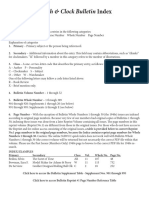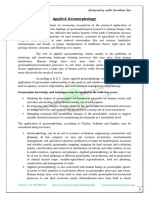Public Information Circular 38 • November 2015
Kansas Geological Survey
Kansas Geologic Maps
Robert S. Sawin, Catherine S. Evans,
and
John W. Dunham
, Kansas Geological Survey
Terms in
bold
are dened in the glossary.
Introduction
Geology is a part of our everyday lives, usually in ways we don’t think about. Not anticipating the effect our activities may have on our natural surroundings and the effect geology may have on us can be expensive, both economically and environmentally. In Kansas, geologically related disasters cost businesses and individuals millions of dollars each year and endanger lives. Highways sink, buckle, or are displaced; houses slide down hillsides; buildings
crack or are inltrated by groundwater.
Understanding the near-surface geology and incorporating geologic evaluations into planning processes can prevent many structural and environmental problems and keep people safe. Geologic maps, the principal source of information about the geology and natural resources at or near the surface, are essential for evaluating natural resources, making economic decisions, and guiding public policy. The Kansas Geological Survey (KGS) makes basic geologic information about the state available to the public through its county geologic mapping program. This circular explains what geologic maps are, how they are made, what they are used for, why they are valuable, and where to obtain them for Kansas.
What is a Geologic Map?
Geologic maps (g. 1)
depict
bedrock
—the solid rock at the Earth’s surface or directly beneath the vegetation, soil, and thin deposits of unconsolidated material collectively called “cover.” Limestone, sandstone, and shale are common types of bedrock in Kansas. Soils and thin, unconsolidated surface or near-surface materials derived from bedrock through erosion are considered part of the cover and are generally not shown on geologic maps. However, in areas where bedrock is covered with thick and widespread deposits of sand, gravel, clay, silt, and other materials carried in by wind, water, and ice, the deposited material instead of the deeper bedrock is depicted on the map. Sediment deposits up to tens of feet thick in Kansas include alluvium, loess, sand dunes, and glacial drift. Alluvium consists of unconsolidated sand, gravel, clay, and silt that has been carried in by water in recent geologic
time and deposited on ood plains or
in stream valleys. Loess (pronounced in various ways but often rhymed with “us”) is a thick layer of
unstratifed
sediment—mainly silt derived from glacial materials and deposited by the wind. Sand dunes are formed from windblown material—mainly sand derived from alluvial deposits. Glacial drift is composed of rock fragments and sediment—from massive boulders to silt—eroded, transported, and deposited by glaciers or glacial meltwater.
Figure 1—Portion of the Tallgrass Prairie National Preserve geologic map (Chase County). The bedrock geology includes layers of limestone—some with embedded chert, or int—mudstone, and shale representative of the Flint Hills. Colors in the key represent rock units shown on the map.
Pba


2
Each geologic map graphically portrays the type, age, and distribution of surface or near-surface rock units in a state, county, region, or area of interest, such as the Tallgrass Prairie National Preserve in the Flint Hills in
Chase County shown in g. 1. Each unit is identied and named based
on distinctive characteristics that can be mapped over large distances. For example, the Wreford Limestone, named after the unincorporated community of Wreford in Geary County, is found throughout the Flint Hills, including in the preserve and in roadcuts along Interstate 70. Attributes that help distinguish Wreford Limestone from other rock units include its thickness and the presence
of chert, also called int.
Lines, symbols, and colors are used on a geologic map to show the relationship between rock units and to accentuate the three-dimensionality
of the bedrock geology (g. 2). Folds,
faults, fractures, and other geologic features created by deformation and displacement of the rocks are shown where they would appear if the overlying soil were stripped away. Lakes, rivers, roads, towns, and other natural and cultural features are included to help users pinpoint locations. A rock column showing the names and descriptions of each rock unit and the order in which
they were deposited over time (g. 3)
is included on each map. The KGS also provides a general description of the local geology and water and mineral resources. Geologic maps often have a
geologic cross section
that represents a vertical slice of subsurface rock layers
through a designated area (g. 4).
Benefts and Uses
Compiled from the most comprehensive
information available—including rst-hand eld observations and previously
published maps and reports—geologic maps and the digital data associated with them are the best starting point for any project concerning the use, conservation, or study of natural resources. They can be useful when
• Evaluating landslides, earthquakes,
and sinkholes
• Designing and constructing
highways, bridges, and tunnels
• Building schools, sports stadiums,
skyscrapers, and other structures
• Planning transportation and utility
routes
• Planning for urban growth and
recreation
• Siting and excavating lakes and
ponds
• Selecting sites for landlls, treatment
facilities, and underground storage tanks
• Planning land use and evaluating
land-use proposals
• Assessing, exploring, developing, and
managing natural resources
• Developing and protecting
groundwater resources
• Writing government regulations• Carrying out basic earth-science
researchEngineers, architects, developers, and city planners, in particular, use geologic maps to assess the feasibility of construction and development at a
specic site to avoid safety, health, and nancial risks. When the location of a oodplain or landslide hazard is not
considered during urban development, a preventable disaster could occur. If building construction is not adapted to the local geology, concrete may crack, foundations may shift, basements
may ood, and large structures may even collapse. Dam failures due to
unstable geology endanger downstream communities and farms. On a smaller scale, a landowner can use a geologic map when choosing a site to drill a domestic water well or construct a farm pond. For example, a pond built in shale containing clay that forms a tight seal should hold water while one built in sand and gravel, on porous sandstone, or on fractured limestone will likely drain. The information on geologic maps is helpful, and often essential, for any project that will affect or be affected by the type and structure of the underlying bedrock, water resources, and other natural resources. Assessing the geology of a site before altering it in any way increases the chance of foreseeing and avoiding construction failures, environmental damage, and natural disasters. Once a problem has occurred, such as the landslide that took out a
section of McDowell Creek Road south of Manhattan in 1995 (g. 5), geologic
maps are used to evaluate the surface geology, plan reconstruction, and avoid future problems.
Making Geologic Maps
Geologic maps are made by scientists with the training and experience needed to identify rocks at the surface; make inferences about the near-surface geology underlying the cover of soil, vegetation, and thin deposits of unconsolidated materials; and graphically depict the bedrock as it would appear without the cover.To create a geologic map, one or more geologists start by assembling existing geologically related materials for the mapping area. These include aerial photographs,
remote sensing
data,
measured
stratigraphic sections
, highway construction plans, shallow
core
and
borehole
records, geologic cross sections, water-well records, soil surveys, and published books, articles, and maps. The information from these sources is used to locate rock units and
geologic features during eldwork and to interpret data collected in the eld.During eldwork, geologists
systematically drive and walk along roads, streams, and hillsides to examine surface materials and locate outcrops—the portions of rock units exposed at the Earth’s surface. Outcrops can occur naturally, for example where rock has eroded along streams and cliffs, or they can be human-made, such as those in
quarries and roadcuts. Geologists will
examine each rock exposure in detail to identify the rock units and geologic contacts, which are the boundaries between the rock units based on the type
and age of the rocks (g. 6).
Understanding the
stratigraphy
,
or sequence of rock layers, is an
important part of the mapping process.
Rocks beneath the surface or visible
in outcrops are layered in the order in which they were deposited, unless they were displaced by faulting, folding, or
other processes. Bedrock type varies
from one place to another, even in a small area, because geological processes (deposition, erosion, etc.) are rarely uniform across a mapping area. To assure consistency from one county to the next, layers of bedrock are
identied according to long-established boundaries and names (g. 3). Unit
boundaries usually represent a change from one predominant rock type to another, such as shale to limestone. In Kansas, the thickness of each unit ranges from a few feet to tens of feet. Geologists
3
Figure 2—Portion of the Saline County geologic map southwest of Salina, which includes Coronado Heights, the Smoky Hill Buttes, and I-135/U.S. Highway 81 and Kansas Highway 4. Names of the rock units (identied by colors) are shown in g. 3. Photo: Coronado Heights, a scenic overlook and park, as seen from the east (bottom left on map).Key: Green lines = highways; heavy red lines = primary roads; gray lines = light duty roads; brown lines = contour lines showing elevation; red numbers = section numbers (part of a legal description used to identify properties).
4
Figure 3—Stratigraphic column showing geologic units on the Saline County map in g. 2, from oldest to youngest (bottom to top). Mbr = member; Fm = formation; Sh = shale.Figure 4—Geologic cross section (from Saline County map) illustrating a vertical section of the subsurface rock layers along a line running west to east across the county. The line runs through southern Salina, which is located in the Smoky Hill River valley. I-135 and the Smoky Hill River in this area run perpendicular to the cross section. Names of the rock units (identied by colors) are shown in g. 3. Cross hatching in the Wellington Formation represents the Hutchinson Salt Member. The bottom of the cross section is about 350 feet below the surface. Rocks beneath the Wellington, the oldest formation found at the surface in Saline County, are not included on the cross section.
often record the locations of outcrops and other information
gathered in the eld electronically on tablet PCs with built-
in GPS (Global Positioning System). They may also digitally photograph the geologic attributes of each outcrop and, if warranted, measure and describe the stratigraphic section,
or
sequence of rock units, visible at the surface. Outcrop locations
are referred to as “control points” because their geologic
attributes have been observed and veried.
Geologic maps are compilations of data and inference.
Because control points may be a mile or more apart and
the bedrock in between is hidden by soil and vegetation,
geologists must connect the points and ll in the gaps between them by extrapolating and interpreting the geology. Besides
outcrops, other clues are available. For example, certain plants
or patterns of vegetation commonly overlie specic types of
bedrock; soils contain materials weathered from underlying bedrock; and records for water wells and exploratory boreholes, when available, document near-surface rocks encountered during drilling.
In the eld, and later when compiling data used to create a
digital map, geologists can use
GIS
(geographic information
systems) to combine data collected in the eld with existing
data available in other formats, including
topographic maps
, color aerial imagery, black and white aerial photography, soils maps, and
LiDAR
(Light Detection and Ranging) imagery. Overlaying the location of rock units identied in the eld onto these other maps and images helps geologists visualize, analyze, and interpret the geology within the mapping area.
Geologists—working with a
cartographer
—use lines, colors, and symbols to distinguish the various rock units and resources of the surface and near-surface geology. The geology is superimposed on a topographic base. That is, the information that appears on existing topographic maps for the area being mapped, including streams, lakes, roads, towns, and contour lines indicating elevation, also appears on the geologic map.
Hill shading, generated from LiDAR imagery, is added to give a
three-dimensional effect.The KGS mapping program produces geologic maps by
county, but the geologists rst plot their eld data on more detailed U.S. Geological Survey 7.5-minute topographic maps (g. 7). On these maps, 1 inch on the map equals about 2,000
West East
Pn







